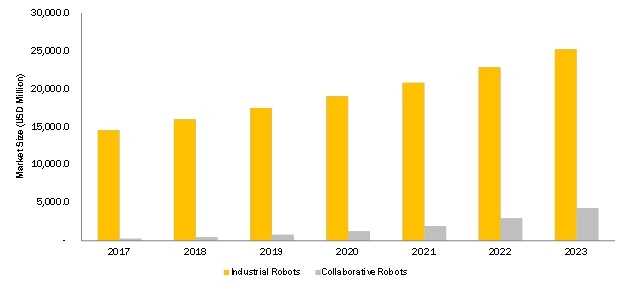Technology overview
Collaborative robots (also known as co-bots; an emerging automation technology) are designed to work alongside humans with precision, strength, and speed for achieving high efficiency in production. Collaborative robots differ from industrial robots in several ways, such as the absence of “safety fence” while working alongside humans, simplified programming and reduced setup time, integration of auto-speed reduction and distance monitoring or proximity sensors, and ability to reduce motor power and force in case a worker is working too close to the co-bot. Co-bots are safe and easy to operate, and yield quick return on investment (ROI). These robots offer quick ROI owing to their numerous advantages, such as easy installation, simple programming, no additional costs (such as those incurred to build and maintain safety fencing in traditional industrial robots), less costly tools and accessories (such as grippers, cameras, and laser systems), and acceptance by workforce. Co-bot operations are primarily governed by ISO 15066:2016 standard that further specifies various safety requirements. ISO 10218-1:2011, RIA/ANSI R15.06-2012, ISO 12100:2010, and ISO 13849-1:2008 are a few other standards governing safe operations of co-bots. Continuous advancements in sensor technologies, software, and end-of-arm tooling (EOAT) are further expanding collaborative robot capabilities and applications. Co-bots can perform a myriad of tasks that are not feasible using traditional industrial robots. Small and medium-sized enterprises (SMEs) are the major potential customers of co-bots where operations involve light-duty tasks, such as assembly, pick and place, machine tending, and quality inspection, which could be of low value and riskier if done by industrial robots. As per MarketsandMarkets’ analysis, the overall collaborative robot market is expected to be worth over USD 8 billion by 2025, growing at a CAGR of ~55% from 2018 to 2025.
The marketspace of collaborative robots is expected to undergo phenomenal expansion in the nearest future because of significant traction from SMEs worldwide owing to recognizable benefits of co-bots, reduced total cost of ownership (compared with other low-payload industrial robots), and one-stop solution for safe working environment while offering advanced industrial automation solutions to end users. Recent geopolitical phenomenon bolstering the manufacturing sector in developed nations across North America and Europe; rising factory floor automation in China, Japan, and India; growing integration of artificial intelligence (AI) into existing robotics infrastructure; enhancements in 3D machine vision technology; and the potential of cloud robotics to realize connected workspace are some of the key trends to watch out for in the collaborative robotics ecosystem. The shortage of skilled workforce for low-value tasks (such as assembly and pick and place) and limitation of traditional industrial robots in agile and flexible operations while complying with certain safety standards are further opening new growth avenues for co-bots not only across the manufacturing sector but also other sectors such as food, consumer packaging, and healthcare.
FIGURE 1
Industrial Robot market vs. Collaborative Robot market (2017–2023)

Source: Industry Journals, Company Websites, Annual Reports, Press Releases, Expert Interviews, and MarketsandMarekts’ Analysis
Collaborative robots accounted for ~2% of the global industrial robot market in 2017; the market for co-bots was valued at USD 286.8 million in 2017. The share of collaborative robots is expected to increase significantly from 2017 to 2023; these are expected to account for ~17% of the global industrial robot market by 2023; the market for these robots is expected to be valued at USD 4,284.4 million by 2023.
Key Drivers for Collaborative Robots
High ROI and low price of collaborative robots attracting SMEs
Depending upon the working capacity and use, most co-bots offer ROI in a span of 6–12 months, and a few co-bots offer ROI within a period of 3–6 months. The collaborative robot market is highly competitive, wherein some players offer higher payload capacity co-bots and enjoy competitive advantage over others. FANUC’s CR-35iA (~USD 80,000) is one of the earliest collaborative robots with a payload capacity of up to 35kg. KUKA’s LBR iiwa is another co-bot priced at ~USD 100,000. ABB’s YuMi and Kawada’s NEXTAGE are other high-priced dual-arm co-bots priced at ~USD 40,000 and ~USD 60,000, respectively, because of the complexity involved in operating these co-bots. Co-bots from other leading manufacturers — UR3 and UR5 from Universal Robots (Denmark), Baxter and Sawyer from Rethink Robotics (US), TM5 Series from Techman Robot (Taiwan), and OB7 from Productive Robotics, Inc. (US) — are available at a price range of USD 20,000–40,000. Rising demand for low-cost co-bots, such as AUBO-i5 from AUBO Robotics (US), Eva from Automata Technologies Limited (UK), and Panda from Franka Emika GmbH (Germany), is further expected to fuel competition in the collaborative robotics market, which in turn will drive down the prices of co-bots in the upcoming years. Considering the additional cost of robot peripheral integration (i.e., the total cost of installing 1 robot, along with the complete set of necessary peripherals and equipment), the cost of integrating a co-bot could reach up to USD 100,000, which is still far less than the total cost incurred in case of conventional industrial robots.
Co-bots come as a packaged solution, comprising all the necessary accessories from manufacturers. The depreciation rate of co-bots is lesser than that of traditional heavyweight industrial robots. These robots can just be plugged in to start functioning, which reduces time, manpower, and floor space, and increases productivity when deployed on a large scale. Co-bots also offer agile manufacturing, and if required, they could be easily deployed from one production line to another without the hassle of changing the programming—i.e., co-bots could be trained by simply hand-guiding their arms—thereby eliminating the need for an expert-level software programmer to reprogram the entire coding of the robot.
Increasing investments in automation by industries
The robot revolution has made automated machines a part of daily life and has gone beyond industrial applications. Companies with expertise in different fields of automation and robotics are investing heavily in robotic ventures. For instance, KUKA AG (Germany), through its investment (acquisition) in Reis Robotics, gained access to new sectors such as foundry, solar energy, and battery production, which helped KUKA in bundling the competence in automated systems.
The robotics sector, through mergers and acquisitions, is providing the companies access to the fast-growing robotics industry. The use of industrial robotics has accelerated automation in an intelligent way, offering functional benefits such as production flexibility with enhanced product quality, improved production output with decline in operating costs, and provision of floor space for utilization. As a result, the automation industry is driving the market for industrial robotics.
The economics of robotics companies is improving with more units being sold in recent years, giving automation a new face. Drivers for this are co-bots with better technology, as well as developments in many regions worldwide. The collective benefits of adopting robotics would increase production with human–robot interface on the same floor. Industrial robotics automation offers the most viable opportunities for investment in sectors such as logistics and e-commerce, healthcare, defense, and agriculture. Automation and technological advancements are further favoring the adoption of collaborative robots by several end-user industries.
Current market scenario
FIGURE 2
AUTOMOTIVE INDUSTRY TO LEAD THE MARKET, IN TERMS OF VALUE, BY 2023

Source: Industry Journals, Company Websites, Annual Reports, Press Releases, Expert Interviews, and MarketsandMarekts’ Analysis
Primary industrial verticals for co-bots are electronics; automotive; metals and machining; plastics and polymers; food and agriculture; furniture and equipment; healthcare; scientific research; logistics; education; consumer goods; and die cast and foundry. The automotive industry accounted for the largest share of the collaborative robot market in 2017. In this industry, co-bots are used to perform diverse assembly tasks. Other crucial tasks involving co-bots in the automotive production line are pick and place, quality inspection, packaging and palletizing, machine tending, and material handling.
In 2017, Europe led the collaborative robot market in terms of market share, followed by Asia Pacific and North America. Germany held the largest share of the European collaborative robot market, followed by the UK and France. The growth of the market in Europe was driven by strong government support to promote factory automation solutions, thus supporting Industry 4.0 drive. Many authorities in Europe have collectively or independently developed human–robot collaboration and protection guidelines, which are driving this market.
Universal Robots A/S (Denmark) and ABB Ltd. (Switzerland) are 2 of the key players in the collaborative robot market. Universal Robots offers UR3, UR5, and UR10 collaborative robots named after their payloads in kilograms. The company launched its first robot in December 2008 and currently leads the collaborative robot sector. In June 2016, Universal Robots A/S (Denmark) launched Universal Robots+—an online user-friendly platform allowing users to easily customize robots as per their unique requirements. The company expanded its business operations in the US and India during 2016 to further increase its market reach in these countries.
ABB Ltd. (Switzerland) offers IRB 14000 YuMi, a dual-arm collaborative robot, which is used in a range of light-duty applications, such as small parts assembly, testing and packaging, electronic parts and components assembly, and consumer products assembly. YuMi has a payload capacity of 500g per arm and an overall weight of 38kg; it can move at a maximum velocity of 1,500mm/s. ABB also provides software support (under SISTEMA brand) for its YuMi robot. The company mainly focuses on expanding the reach of its co-bot into new geographies and acquiring other market players. For instance, in June 2017, ABB expanded the presence of its YuMi collaborative robot in the Netherlands by installing 3 YuMi co-bots on a production line at electrification products plant in Ede. In July 2017, ABB further strengthened software support for its robotics business with the acquisition of Bernecker + Rainer Industrie-Elektronik GmbH (Germany). Rising competition among existing co-bot manufacturers and the entrance of new players in the collaborative robot market (such as Techman Robot (a subsidiary of Quanta Storage, Inc., Taiwan) in 2012, Productive Robotics, Inc. (US) in 2013, and Franka Emika GmbH (Germany) in 2016) will further drive down the prices of collaborative robots in the nearest future. Collaborative robots, however, are less powerful and slower than traditional industrial robots, which becomes a challenge in handling a wide range of industrial-grade operations.
Conclusion
Collaborative robots are used in several industrial and service applications. The market is growing at a rapid pace owing to technological advancements and the integration of automation tools. The applications of collaborative robots have been increasing from automotive, packaging, distribution, and metalworking to inspection, mobile platforms, and human–machine interaction. However, making collaborative robots safe for routine interaction with humans is a major technological challenge that the robotics industry has been facing for a long time.
In industrial applications, for operating in more than 6 axes (degrees of freedom), co-bots require complex programming and compact assembly to perform an activity. As the ongoing trend of robotics requires the merger of mechanical and software engineering, many companies are capitalizing on this for enhancing their expertise in mechatronics and software.
Complex programming and multiple sensors are required for making a collaborative platform that can operate autonomously to provide a degree of intelligence and reliable mechanisms while performing a particular task. Apart from multiple-axis control, precise motion control has been a major technological challenge for operating alongside humans.
Furthermore, robot manufacturers face challenges while fixing the price and increasing the life expectancy of co-bots. Robot operating capabilities are needed to be scaled while making the system operational with precise real-time environments with instant system response and performing a defined set of steps. For example, modest changes in lighting conditions may also result in considerably divergent behaviors in robots. These technological challenges need to be addressed effectively to make humans confident enough to work alongside robots.
References :
- https://www.marketsandmarkets.com/Market-Reports/collaborative-robot-market-194541294.html
- https://www.marketsandmarkets.com/Market-Reports/Industrial-Robotics-Market-643.html
Author Details

Name: Amritpal Singh Bedi
Designation: Research Analyst
Key Areas of Interest: Service Robotics, Collaborative Robotics, 3D Printing, Roll-to-Roll Printing, and Industrial Refrigeration, among others
Academic Qualification: MBA (Marketing), B. Tech (Electronics and Communication)

You must be logged in to post a comment Login